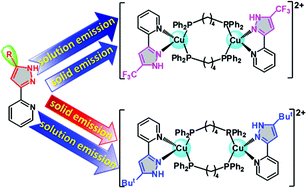Luminescent dinuclear copper(i) complexes bearing 1,4-bis(diphenylphosphino)butane and functionalized 3-(2′-pyridyl)pyrazole mixed ligands†
Abstract
A family of new dinuclear Cu(I) complexes with 1,4-bis(diphenylphosphino)butane (dppb) and functionalized 3-(2′-pyridyl)pyrazole mixed ligands has been synthesized and characterized. It is revealed that all these Cu(I) complexes include a [Cu2(dppb)2]2+ framework with the two Cu(I) atoms doubly bridged by a pair of dppb to generate a fourteen-membered Cu2P4C8 ring, and functionalized 3-(2′-pyridyl)pyrazole adopts a neutral chelating coordination mode without the N–H bond cleavage of the pyrazolyl ring. All these dinuclear Cu(I) complexes display a relatively weak low-energy absorption in CH2Cl2 solution, which is closely related to the variation of the Cu–N and Cu–P bonds caused by the substituent on the pyrazolyl ring. These dinuclear Cu(I) complexes are all emissive in solution and solid states at ambient temperature, which can be well modulated through structural modification of 3-(2′-pyridyl)pyrazole. It is shown that introduction of the trifluoromethyl group into the pyrazolyl ring is helpful for enhancing the luminescence properties of Cu(I) pyrazole phosphine complexes.


 Please wait while we load your content...
Please wait while we load your content...